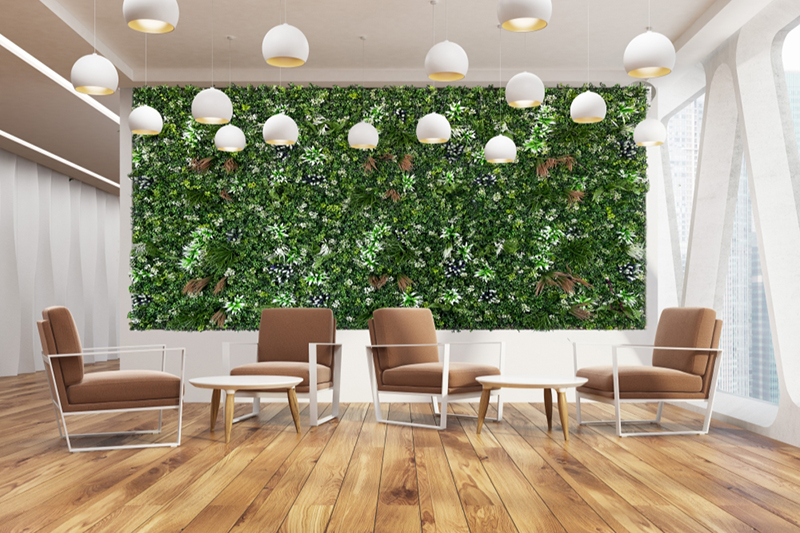3D artificial vertical gardens are emerging as sustainable solutions for urban environments, offering eco-friendly alternatives to traditional green walls or living plant installations. By leveraging artificial foliage, these gardens address environmental challenges while minimizing resource consumption. Below are key ways in which 3D artificial vertical gardens contribute to ecological sustainability.

One of the most significant environmental advantages of artificial vertical gardens is their water efficiency. Unlike living plants, which require regular irrigation, artificial foliage needs no watering, eliminating the strain on local water supplies. In arid regions or areas prone to drought, this feature is particularly valuable, as it reduces the demand for precious freshwater resources.
Artificial vertical gardens also prevent water waste associated with overwatering, runoff, or evaporation. Traditional green walls often rely on complex irrigation systems that can leak or malfunction, leading to wasted water and potential structural damage. In contrast, artificial installations require no plumbing or drainage, making them ideal for water-scarce environments or buildings where water conservation is a priority.
Furthermore, the absence of watering reduces the energy required to pump and treat water, lowering the overall carbon footprint of the garden. This makes artificial vertical gardens a practical choice for regions struggling with water scarcity or seeking to reduce their ecological impact.
Artificial vertical gardens contribute to carbon reduction in multiple ways. First, they eliminate the need for fertilizers, pesticides, and herbicides, which are often energy-intensive to produce and transport. These chemicals can also contaminate soil and waterways, harming ecosystems. By using artificial plants, vertical gardens avoid these environmental risks entirely.
Second, the maintenance of artificial gardens generates far fewer carbon emissions compared to living plant installations. Traditional green walls require regular pruning, trimming, and replacement of dead or diseased plants, often involving fossil-fuel-powered tools or vehicles for transportation. Artificial gardens, however, need only occasional cleaning with eco-friendly detergents and water, significantly reducing the frequency of maintenance visits and associated emissions.
Additionally, the longevity of artificial foliage reduces the need for frequent replacements, further cutting down on manufacturing and transportation-related carbon outputs. This durability ensures that the garden remains functional and aesthetically pleasing for years without the environmental costs of constant upkeep.
While artificial vertical gardens do not directly host flora or fauna like living green walls, they can indirectly support biodiversity by creating microhabitats or reducing urban heat islands. For example, the shade provided by artificial foliage can lower surface temperatures on buildings, mitigating the heat island effect and making urban areas more hospitable for wildlife. Cooler temperatures can also benefit insects, birds, and small mammals that rely on shaded areas for rest or nesting.
In some cases, artificial vertical gardens are designed to incorporate nesting boxes, insect hotels, or bird feeders, transforming them into hybrid installations that combine artificial greenery with wildlife-friendly features. These additions encourage biodiversity by providing food, shelter, and breeding grounds for urban wildlife.
Moreover, by replacing hard surfaces like concrete or metal with greenery, artificial vertical gardens improve air quality and reduce noise pollution, creating healthier environments for both humans and animals. While not a substitute for living ecosystems, these gardens can play a supportive role in urban biodiversity initiatives.
Modern artificial vertical gardens are increasingly designed with recyclability in mind, ensuring that materials can be repurposed or reused at the end of their lifespan. High-quality artificial foliage is often made from recycled plastics or other sustainable materials, reducing reliance on virgin resources. When the garden is decommissioned, these materials can be processed into new products, closing the loop on waste.
Some manufacturers offer take-back programs or partnerships with recycling facilities to streamline the disposal process. This proactive approach to end-of-life management prevents artificial plants from ending up in landfills, where they could take centuries to decompose. By prioritizing recyclability, designers and builders can ensure that artificial vertical gardens align with circular economy principles.
Additionally, the durability of artificial foliage means that fewer resources are consumed over time compared to living plants, which may need to be replaced multiple times due to disease, pests, or environmental stressors. This longevity reduces the overall environmental impact of the garden, even when accounting for manufacturing and disposal.
Artificial vertical gardens excel in environments where living plants would struggle to survive, such as areas with high pollution, extreme temperatures, or limited sunlight. In industrial zones or busy urban corridors, air pollutants like particulate matter, nitrogen oxides, or sulfur dioxide can damage or kill living plants. Artificial foliage, however, is unaffected by these conditions, allowing green spaces to thrive even in challenging environments.
By installing artificial vertical gardens in polluted areas, cities can improve aesthetic appeal and public perception without the maintenance challenges of living plants. These gardens can also serve as educational tools, raising awareness about environmental issues while demonstrating sustainable design solutions.
Furthermore, artificial installations are ideal for temporary or mobile structures, such as construction sites, festivals, or pop-up events. Their portability and low maintenance requirements make them a practical choice for greening spaces that would otherwise remain barren, contributing to a more sustainable urban fabric.
3D artificial vertical gardens offer a range of environmental benefits, from water conservation and carbon reduction to indirect support for biodiversity and recyclability. By addressing the limitations of living plant installations while maintaining visual appeal, these gardens provide a sustainable alternative for urban greening. As cities continue to grapple with climate change and resource scarcity, artificial vertical gardens will play an increasingly vital role in creating eco-friendly, resilient, and livable environments.
Contact: Amy
Phone: 86-15311787313
E-mail: info@foszmac.com
Whatsapp:86-15311787313
Add: Fengtai District, Dacheng Road, No.24 Building, Room 203, Beijing, China